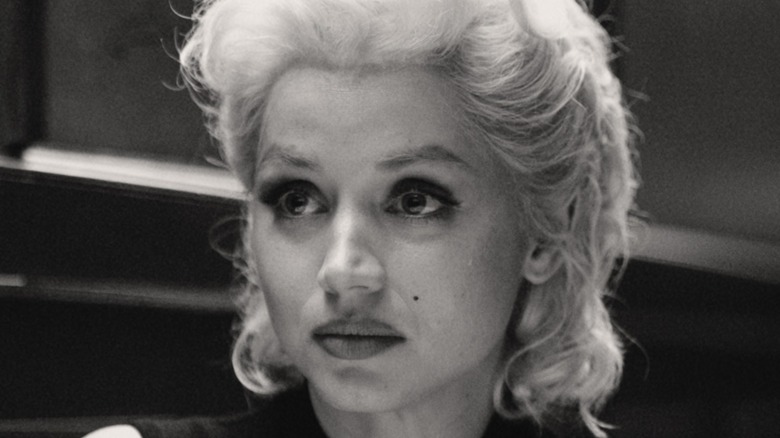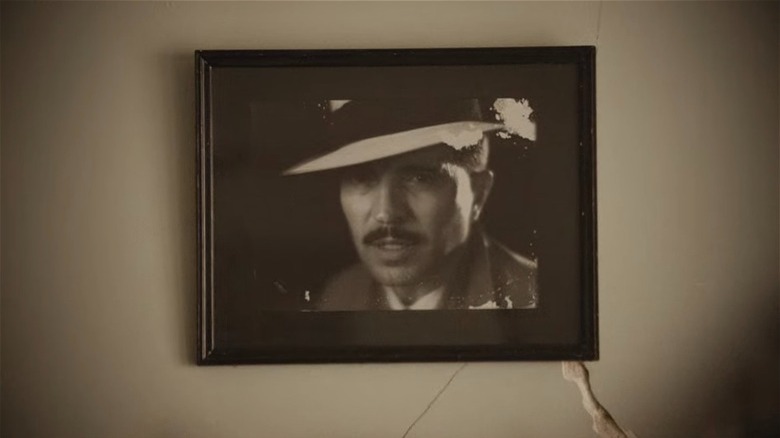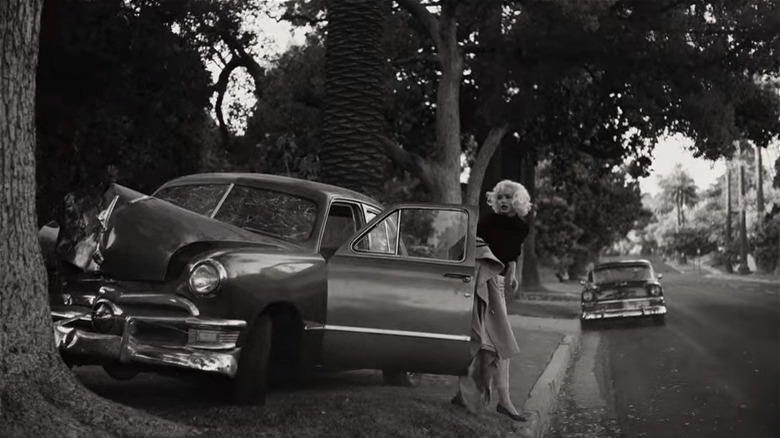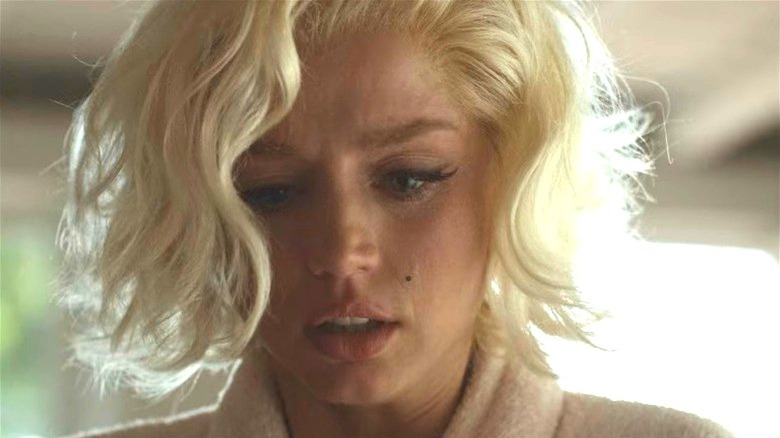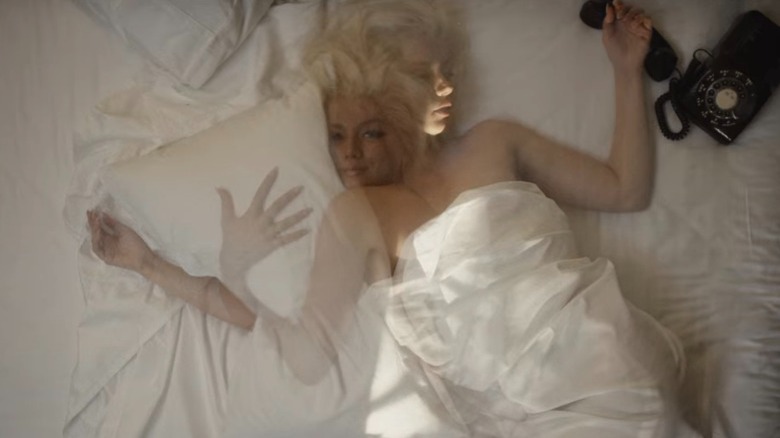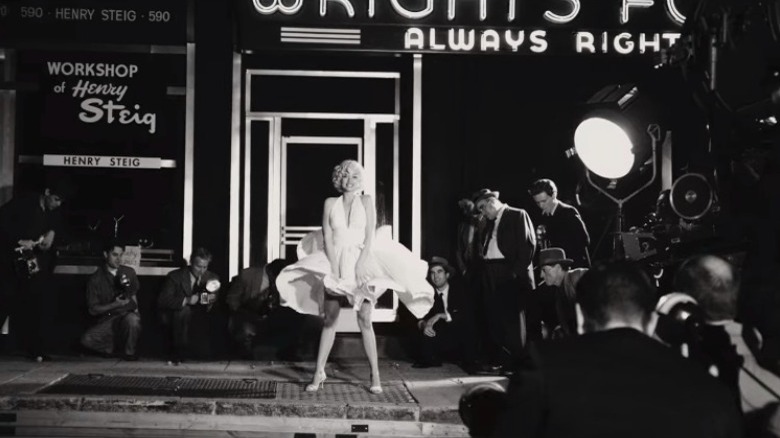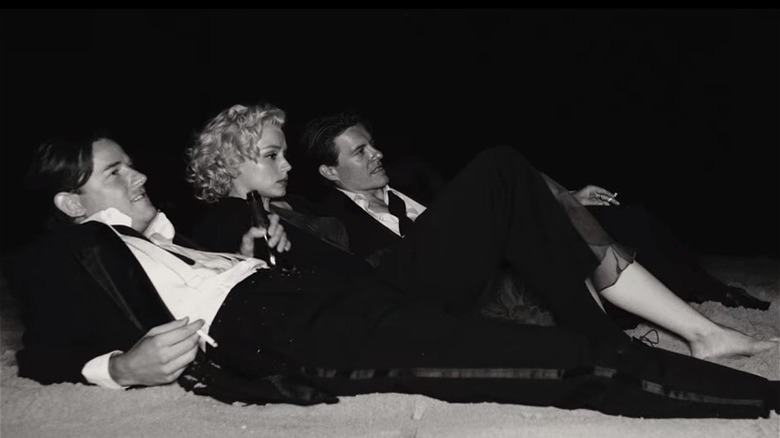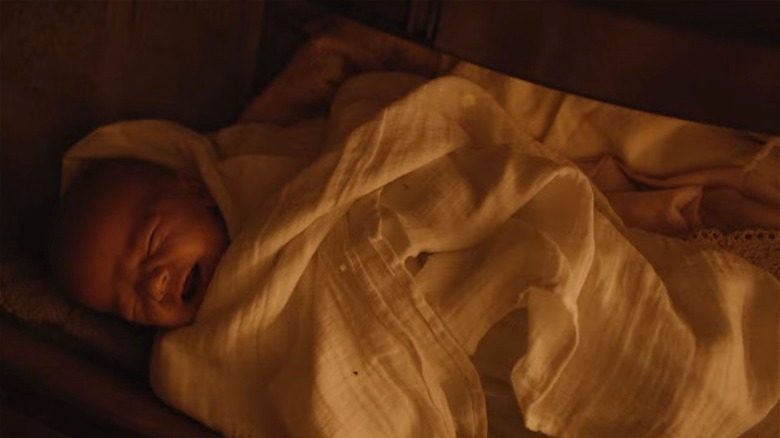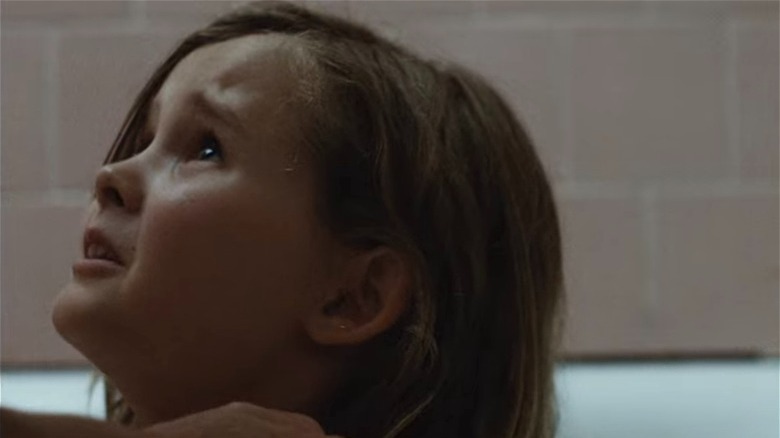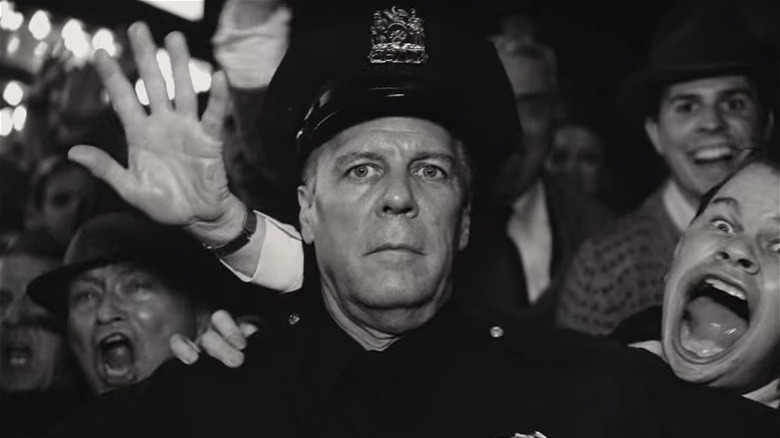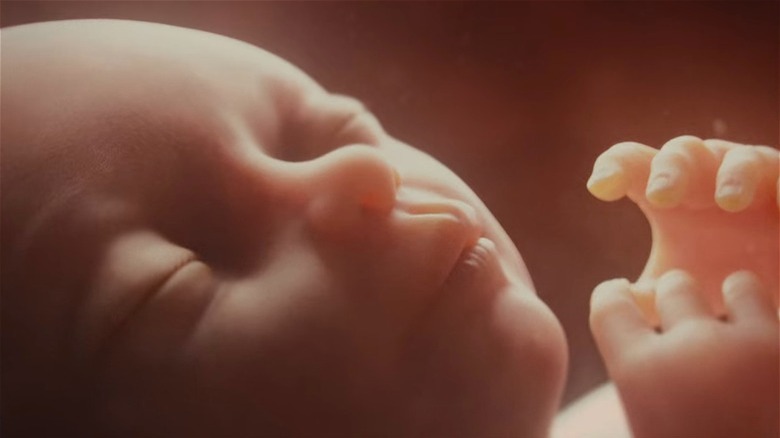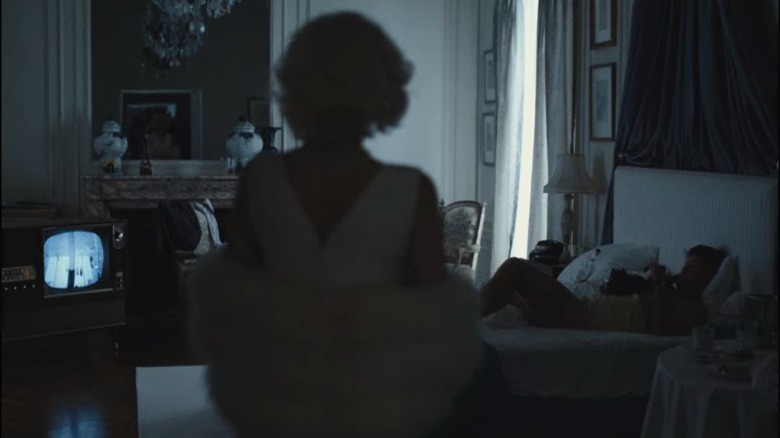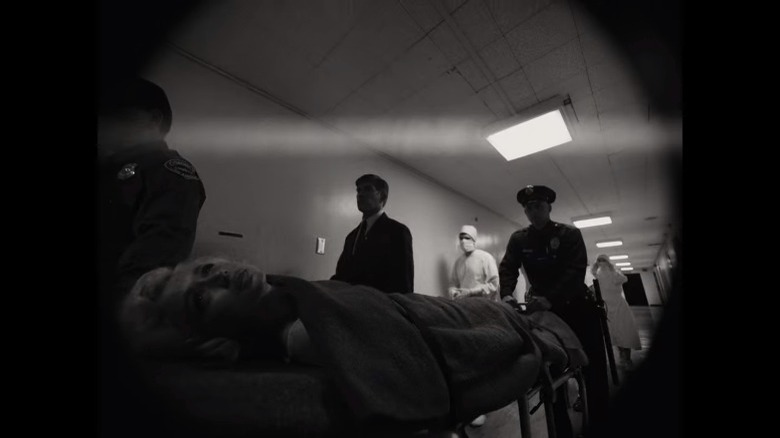The 12 Wildest Moments In Blonde, Ranked
Warning: This article contains major spoilers for "Blonde."
Andrew Dominik's "Blonde," a fictional look at the trauma and tumult in the life of cinematic icon Marilyn Monroe, bears only a passing resemblance to reality. Instead, the film — which is an adaptation of Joyce Carol Oates' book of the same name — is an unending string of disappointments, degradations, humiliations, and pain. Over the course of 2 hours and 47 minutes, Marilyn is beaten, raped, lied to, cheated on, exploited, and more. It's a punishing watch. There's plenty of bold filmmaking involved, but is it worth the cost?
Throughout the film a number of wild moments take the action — and the unpleasantness — to a whole new level. Dominik's film isn't just unconcerned with the truth; it's explicitly uninterested in grounding the story in any kind of reality. "Blonde" features multiple dream sequences and plenty of hallucinations, leaving us unsure as to what, exactly, is going on. These are the 12 wildest moments in "Blonde," ranked from the most confusing and ridiculous to those that are downright offensive.
12. The portrait of Marilyn's father speaks
Before we can even register what kind of movie we're watching, the younger version of Marilyn (Lily Fisher) is introduced to a portrait of her absent father (Tygh Runyan) by her mother (Julianne Nicholson), who tells the impressionable Norma Jeane the story of how the man disappearance from their lives. "When you were born, your father was far away," she says. "He's at a great distance, even now, and I worry for his safety. But in our hearts, we're wed."
It's an event that will prove to be formative in this fictional version of Norma Jeane's life. While her mother plays piano and Norma Jeane dozes, "Blonde" throws us our first wild moment: The photograph speaks. "I love you, Norma Jeane," it tells her, "and one day, I will return to Los Angeles to claim you." Placing the film squarely in the realm of magical realism is certainly a choice. Further, his words hang over the entire rest of the film; in Andrew Dominik's hands, Marilyn Monroe is a woman defined almost entirely by her father's absence. That's wild.
11. Marilyn's car crash
Director Andrew Dominik told Sight and Sound that he was more interested in recreating iconic images of Marilyn Monroe (Ana de Armas) than he was in telling a story that reflects reality. That becomes extremely clear around the middle of the film, when Marilyn leaves a film set and begins driving recklessly as she's overcome with anguish about her father. After swerving off the road, she crashes her car into a tree.
This never happened. Monroe was famously involved in a car crash, but she wasn't the one behind the wheel. In fact, she wasn't even in the car that crashed. As Jaquo writes, Monroe was in the car with her future husband, Arthur Miller (played in "Blonde" by Adrian Brody), when they were pursued by journalists. The photographer's car crashed, and passenger Mara Scherbatoff, the New York bureau chief for a French magazine, was killed. Monroe and Miller were first on the scene. Reportedly, Monroe was distraught when she found out that someone had died in the crash, and blamed herself.
Dominik's version of this event appears to be based on photographs of the crash, but the director turns it into a moment where Marilyn is a hysterical victim, not an observer. In "Blonde," Marilyn is responsible for the crash. In real life, she was simply too hard on herself. Honestly, the actual event seems like a more interesting and nuanced story.
10. Cass wrote the letters
In a confusing subplot, Marilyn Monroe frequently receives letters from her absent dad. The letter-writer insists that he is her "tearful father," repeatedly promising that he is about to return to her life, just like the talking photograph promised at the beginning of the film. Marilyn spends the entire movie — in other words, most of her life — waiting for her him to finally reappear.
Toward the end of the movie, Marilyn learns that her former flame, Cass Chaplin Jr., has passed away (in reality, Chaplin outlived Monroe by several years, as per IMDb). She soon receives a package from Cass that includes a stuffed tiger they found together on a date, as well as a card emblazoned "To My Daughter." Inside, Cass confesses that he was the one who was writing her the letters and pretending to be her dad.
It feels like a twist for a twist's sake. Up until this point, Marilyn's relationship with Cass seemed like one of the only happy times in her life. And yet, in the film's final act, we learn that he too was manipulating her, making him just another in a long line of men who took advantage of Marilyn's naïveté. It's a disappointing end to a muddled plotline, and offers a reason for Monroe's declining mental health that doesn't really add up.
9. Marilyn's seductive ghost
The entire last act of "Blonde" shows Monroe's long, slow mental decline. "She's not a well girl," someone explains to a director named Billy — presumably, this is Billy Wilder, director of "Some Like It Hot." That's certainly the case in the film's final moments, when Marilyn takes a number of pills and washes them down with alcohol.
It's presented like an intentional suicide, although the reality surrounding Monroe's death is much murkier. In an interview with the BFI's Sight and Sound, Andrew Dominik repeatedly refers to Monroe as having "killed herself," but The Library of Congress notes that many people believe that she died from an accidental overdose, and that Monroe was likely trying to telephone for help when she passed away.
"Blonde" doesn't shy away from depicting moments that would perhaps be best left off-screen, nor is it a movie interested in preserving Monroe's dignity. So, of course "Blonde" includes an overhead shot of Marilyn lying in bed, dead. In the moment that follows, her ghost separates from her body, rolls over, and poses seductively, staring directly into the camera. The intention behind the shot is clear: The troubled woman lies dead, but the memory of the iconic blonde bombshell lives on. However, the strange execution leaves something to be desired.
If you or anyone you know is having suicidal thoughts, please call the National Suicide Prevention Lifeline by dialing 988 or by calling 1-800-273-TALK (8255).
8. The subway scene
The most memorable image of Marilyn Monroe comes from "The Seven Year Itch," when she stands over a subway grate with her white dress billowing around her. It's an iconic visual, and is sometimes used as shorthand for the whole era. Here, the blonde bombshell is titillating, but she doesn't give away everything.
"Blonde," however, affords its subject no such modesty. Instead, filming the shot goes on and on, and is seen from every conceivable angle — and yes, that includes an absurd number of upskirt shots that reveal everything that's strategically hidden in the original. During this sequence, Marilyn is surrounded by photographers, leering men, studio executives, fans, and a crowd of people that stretches off into the distance, all of whom whoop and holler as her dress flies up into the air. We see the shot repeatedly in black-and-white, and we see it all again in color. It's replicated endlessly, recalling the way the original shot was disseminated.
The intention is probably to make us feel how objectified and dehumanized Marilyn was by her "sexpot" status, but there's a fine line between critiquing harm and simply replicating it. In Andrew Dominik's version of this moment, there is no empowerment to be found. Marilyn isn't cannily using her sexuality to get ahead. She's shamed for it, and we are made complicit by watching.
7. The throuple
A certain freedom comes with making a biopic that's intentionally untethered to reality, and that can sometimes lead to some fun, interesting places. See, for example, an early subplot in "Blonde" that involves Marilyn's three-way relationship with actors Eddy G. Robinson Jr. (Evan Williams) and Charlie Chaplin Jr. (Xavier Samuel), a ludicrous pairing that didn't happen in real life. Still, there's a zany energy to these sequences, and they seem to show Marilyn at her happiest. Her two boyfriends see her as Norma Jeane. They understand that Marilyn is simply a persona, something that very few people in her life seem to grasp.
However, this is still "Blonde." During one scene, Marilyn, Eddie, and Charlie (who's nicknamed "Cass") are in a movie theater watching a trailer for "Niagara," one of Monroe's early films. While her face is splashed across the screen, the three lovers pleasure one another in the middle of the crowd, moaning and panting while Niagara Falls gushes over them. Moments later, after an emotional conversation on the beach, they stare up at the stars, which metamorphose into a vast constellation made up of wriggling sperm. Sure! Why not?
6. The first abortion
"Blonde" includes several abortion sequences, each one of which is wild in its own way. The first occurs when Marilyn Monroe is pregnant with the baby of either Charlie Chaplin Jr. or Eddy G. Robinson Jr. Marilyn decides to terminate her pregnancy so that she can star in "Gentlemen Prefer Blondes," even though she's upset that Jane Russell will reportedly be paid $100,000 while she will only receive $500 a week.
However, when Marilyn goes to her appointment, she has second thoughts. "Please, won't you listen?" she begs the doctors. "I've changed my mind." They pay no attention. Then, "Blonde" does one of the most invasive things in the history of biopics: The camera is placed inside Marilyn's vagina, looking out at the doctor who is about to terminate the pregnancy against her wishes. It's traumatic and upsetting.
As if that isn't enough, Marilyn escapes from the operating table into a hallucination, where she rescues a baby from a dresser drawer as her childhood home burns around her. As a metaphor, it's too on-the-nose: Marilyn is desperate to save the life of a small child because she was unable to stop the abortion from proceeding. Then, the entire thing is undercut by a needle drop, as Monroe's song "Bye, Bye Baby" takes over the soundtrack. It's played like a punchline, and it's so tonally wrong that it's offensive.
5. Gladys tries to drown Norma Jeane
The first part of "Blonde" is about Norma Jeane's childhood, specifically her troubled relationship with her mother. Gladys is downright abusive, and she'll spend the rest of the film in a mental institution, barely able to remember who she is and unable to recognize her daughter.
In those early scenes, though, Gladys wakes Norma Jeane for a late-night car ride through a canyon fire. She then tries to drown her child in a bathtub. Julianne Nicholson's performance is over-the-top on its own, but what makes this sequence extra wild is the voiceover from adult Marilyn, who makes excuses for her mother's actions. "Because she loved the child and wished to spare her grief," Marilyn says. "Because the child was her own secret self, exposed. Because the very father of the child had wished it not to be born ... Because no one could love a child so accursed."
This is the first in a long line of sequences in "Blonde" that reinforces the real Marilyn's tendency to blame herself for her trauma, and juxtaposing a heinous act like this with Marilyn's equivocations is exceedingly uncomfortable to watch.
4. The Some Like It Hot premiere
By the time that Marilyn Monroe attends the premiere of "Some Like It Hot," one of her most well-known films, she's losing her grip on reality. When she gets out of her limousine and begins the long, cacophonous walk up the red carpet, she is overwhelmed by the faces in the crowd calling her name. "Marilyn! Marilyn!" they chant, even though, by this point, Norma Jeane has come to despise her Marilyn persona and no longer sees herself in the character.
The flashbulbs, photographers, reporters, and fans are too much, and Marilyn begins to hallucinate. Many of the faces in the crowd turn grotesque, featuring beady eyes and too-wide, gaping mouths. It's probably meant to resemble a horror movie and put us in Marilyn's headspace. Instead, the effect is silly. It looks more like one of those videos where someone records their TV screen with a Snapchat filter laid on top of the actors. In other words, it's a wild moment because it falls almost completely flat — it's not nearly as striking as it was probably intended to be.
3. The CGI fetus talks
"Blonde" is utterly fascinated with Marilyn Monroe's pregnancies, two of which are terminated intentionally, and the third of which results in a miscarriage. The movie portrays Marilyn as wracked with grief over her first abortion; her guilt undercuts the premiere of "Gentlemen Prefer Blondes," which should have been a joyous occasion, and colors her marriage to Arthur Miller, leaving her nervous as yet another child grows inside her.
While Marilyn gardens in a dress (one she wore in a real series of photos with her husband), "Blonde" imagines a conversation between the "How to Marry a Millionaire" star and her unborn fetus. That's right: The fetus talks back. Via glowing CG shots of the growing child in her womb, the fetus begs Marilyn not to have another abortion. "You won't hurt me this time, will you?" it pleads. "Not do what you did the last time?"
It's a bizarre sequence that shames Monroe for her earlier decision — which, by the way, probably didn't happen. In Donald Spoto's "Marilyn Monroe: The Biography" (via TheCinemaholic), her gynecologist says, "The rumors of her multiple abortions are ridiculous. She never had even one."
2. Marilyn meets the President
When Marilyn Monroe sauntered on stage to sing John F. Kennedy the sultriest version of "Happy Birthday" ever performed, she sparked decades' worth of gossip about what their relationship must have been like. Never mind that, per Woman's Day, there were very few times that the two actually crossed paths — no one could resist speculating about their sex life.
And "Blonde," of course, contains some of the wildest — and yet, most obvious — speculation of all. In the film, Marilyn goes to visit a man referred to only as "the President," but who is obviously JFK. After all, he's played by Caspar Phillipson, who memorably played Kennedy opposite Natalie Portman in Pablo Larraín's "Jackie." When Marilyn walks into the room, the President is on the phone with an unnamed man who chides him about his extramarital affairs, warning him about all of the damage they do to the country.
The President goes on to force Marilyn to perform oral sex on him, during which she dissociates, imagining herself in a softcore porn film. When he climaxes, the droning television shows sequences from the 1956 film "Earth vs. The Flying Saucers" that depict UFOs crashing into DC landmarks like the Washington Monument. Just in case that's too subtle, the voice on the telephone keeps going: "These women, Mr. President. These allegations ... they inflict irreparable harm on America." Okay, Andrew Dominik, we get it. Really, we do.
If you or anyone you know has been a victim of sexual assault, help is available. Visit the Rape, Abuse & Incest National Network website or contact RAINN's National Helpline at 1-800-656-HOPE (4673).
1. The kidnapping
The film's ridiculous take on Marilyn Monroe and JFK's affair is over-the-top, but the absolute wildest moment in "Blonde" actually comes afterwards. Marilyn discovers that she's pregnant once more, and the timing suggests it might be Kennedy's baby. As a result, Marilyn becomes increasingly paranoid, especially once she realizes that men in vans lurk outside her gate. One night, after hearing noises in her house, she wakes up. The sequence is filmed with a night vision effect, so the audience can see the suited men in her bedroom, but Marilyn herself is simply naked and afraid.
Marilyn is kidnapped by these men, who are presumably government agents, and forced to have another abortion — and that's when things become absolutely unhinged. Apparently, one first-person point-of-view shot from inside Marilyn's vagina wasn't enough. "Blonde" dares to do the same thing a second time, although this go-around is filmed in black and white.
We went into "Blonde" knowing that it was going to be a fictional take on Marilyn's life, but really? A clandestine kidnapping and a traumatic, forced abortion to prevent Monroe from carrying John F. Kennedy's secret baby to term? That's what we're doing here? "Blonde" is certainly audacious; whether or not it works, however, is a different story.
